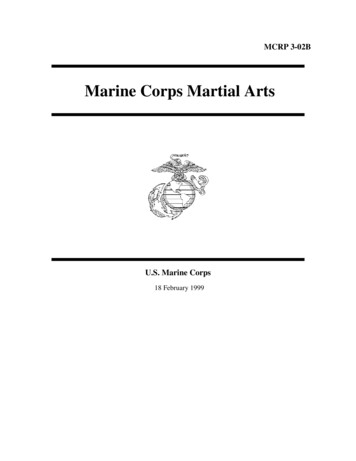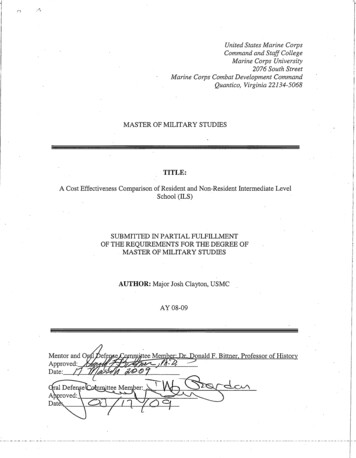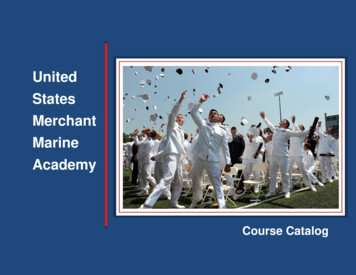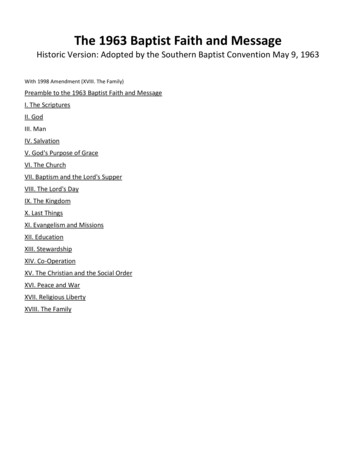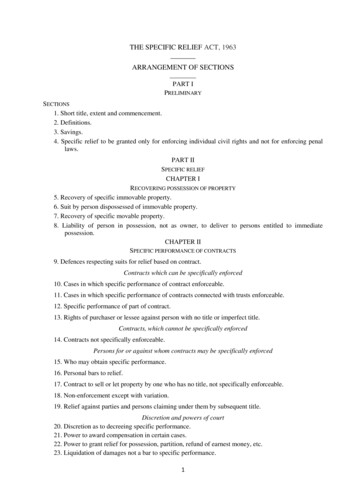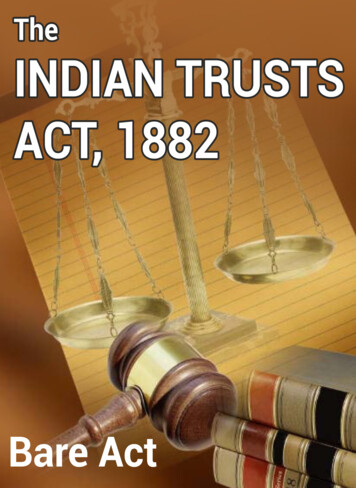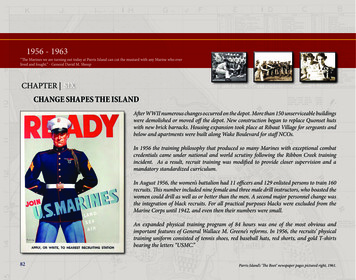
Transcription
1956 - 1963“The Marines we are turning out today at Parris Island can cut the mustard with any Marine who everlived and fought.” - General David M. ShoupCHAPTER SIXCHANGE SHAPES THE ISLANDAfter WWII numerous changes occurred on the depot. More than 150 unserviceable buildingswere demolished or moved off the depot. New construction began to replace Quonset hutswith new brick barracks. Housing expansion took place at Ribaut Village for sergeants andbelow and apartments were built along Wake Boulevard for staff NCOs.In 1956 the training philosophy that produced so many Marines with exceptional combatcredentials came under national and world scrutiny following the Ribbon Creek trainingincident. As a result, recruit training was modified to provide closer supervision and amandatory standardized curriculum.In August 1956, the women’s battalion had 11 officers and 129 enlisted persons to train 160recruits. This number included nine female and three male drill instructors, who boasted thewomen could drill as well as or better than the men. A second major personnel change wasthe integration of black recruits. For all practical purposes blacks were excluded from theMarine Corps until 1942, and even then their numbers were small.An expanded physical training program of 84 hours was one of the most obvious andimportant features of General Wallace M. Greene’s reforms. In 1956, the recruits’ physicaltraining uniform consisted of tennis shoes, red baseball hats, red shorts, and gold T-shirtsbearing the letters “USMC.”82Parris Island’s ‘The Boot’ newspaper pages pictured right, 1961.
Why Parris Island?By 1960, the recruit training core curriculumlengthened from 10 to 12 weeks andconsisted of 5 basic phases:1.2.3.4.5.Forming and processingBasic training, classroom time and drillMarksmanshipMess and maintenanceAdvanced training, combat trainingand inspection(Bayonet training pictured here, circa 1956)PARRISISLAND-COLD WAR19568 April, Ribbon Creek trainingincident occurs.1956Drill instructors are issued thevenerated field hat, popularlycalled the campaign cover.1958Confidence Course isconstructed.
Close order drill instruction circa 1963Leisure time circa 1960Barbed wire training 1950195929 September, HurricaneGracie moves across thedepot.1960The 3rd Recruit Trainingbegins moving into a newbrick complex.1961The 7.62mm M14 rifle isadopted at Parris Island.
1960Ribbon Creek Service86n Creek1, Ribbo7nootaPlcirca 1958
Ribbon Creek 19568 April 1956, a diver crawls out of Ribbon Creek during a recovery operation. Drill InstructorStaff Sergeant Matthew C. McKeon conducted a disciplinary march at night in a tidal basinnamed Ribbon Creek, which resulted in the drowning of six recruits.
During WWII the main gate was moved from Horse Island to its current location. A nearbyguardhouse provided billeting for the Provost Marshall. Entrance way to Parris Island, 1963.
Ribbon CreekOn Sunday, 8 April 1956, between 2000and 2045, Drill Instructor Staff SergeantMatthew C. McKeon, assigned toPlatoon 71, “A” Company, 3d Recruit TrainingBattalion, marched 74 recruits from Platoon71 into Ribbon Creek, a tidal stream, behindthe modern day Weapons and Field TrainingBattalion rifle ranges at Parris Island. Severalof the recruits got into depths over their heads,panic ensued, and six recruits drowned in theresulting confusion. Staff Sergeant McKeonlater testified that the march was traditional,common and intended to develop discipline.Parris Island’s commanding general, MajorGeneral Joseph C. Burger, immediatelyconvened a court of inquiry to investigatethe circumstances. Evidence later presentedin court showed that Staff Sergeant McKeonhad graduated from the Drill Instructor’sSchool and received the highest possible ratingon “motivation,” “emotional stability,” and“hostility factors,” and a better-than-averagerating on “achievement.” After also reviewingthe recruit training directives and program, thecourt was of the opinion that the supervisionand training program was adequate and thatStaff Sergeant McKeon was solely to blame for“conducting an unauthorized and unnecessarymarch by night into an area of hazard.” Itrecommended he be tried by general courtmartial.ways to improve procedures and to provide thetype of Marine recruit graduate desired by theCorps.Funeral service for the 6 recruits drowned from Platoon 71.be commanded by a brigadier general selected by the commandant andwho reported directly to his office on all matters. The recruit trainingcommand would be staffed with selected officers “to supervise andmonitor but not to supplant the drill instructors” during recruit training.On 16 July 1956, Staff Sergeant McKeon’s court-martial trial began atthe Depot Elementary School. It lasted for three weeks and, given thenational attention it had gained, drew in many former Marines to testifyabout recruit training practices. Both the Commandant of the MarineCorps at that time and retired Lieutenant General Lewis B. Pullertestified for the defense.Finally, on 4 August 1956, the court handed down its decision: McKeonwas acquitted of manslaughter and oppression of troops; he was foundguilty of negligent homicide and drinking on duty. The sentence was afine of 270, nine months confinement of hard labor and a bad-conductdischarge. Upon review by the Secretary of the Navy, the sentence wasreduced to three months hard labor and reduction to the rank of private;the discharge was set aside and the fine remitted.Commandant of the Marine Corps GeneralRandolph McCall Pate felt that the MarineCorps itself was on trial in a moral sense forthe death of the six recruits and believed thata reorganization of training procedures andsupervisory methods at Parris Island wasrequired. Thus, a separate recruit training In order to regain the confidence of the American public, all trainingcommand was established at Parris Island, to was now closely supervised by a team of officers, tasked with identifyingDrill instructors were more carefully selected, andthree instructors were assigned to each recruitplatoon instead of two. The campaign coverwas issued in order to offer prestige and allowdrill instructors to be easily distinguished frombasic enlisted personnel. Drill instructors werealso directed to use persuasion, psychology, andleadership as alternatives to pure aggression andauthoritarian disciplinary measures. Unmarrieddrill instructor’s quarters were moved fromrecruit area huts to Page Field, offering regulardecompression periods from the demandingschedule. The Drill Instructor School also adoptedthe Drill Instructor’s Creed.A special training unit was established to developrecruits with specific problem areas: a conditioningplatoon for overweight recruits, a motivationplatoon for the recalcitrant, a proficiency platoonfor the slow learners, a strength platoon for thoserequiring special exercises to build muscles, anda hospital platoon for those requiring medicalattention and rehabilitation. These recruits couldexist in these special training platoons until theycould be reinserted into the regular trainingschedule, often with their original platoons, andsuccessfully complete the training program.The base was made available to the public forcivilians and the press, so that citizens could seefirst-hand the legitimate process of making U.S.Marines. The graduation observance changedfrom a small, unit-based ceremony at a battalionarea to the grand parade celebration that you seetoday.Rescue crew working in Ribbon Creek pictured right.
the modern day Weapons and Field Training Battalion rifle ranges at Parris Island. Several of the recruits got into depths over their heads, panic ensued, and six recruits drowned in the resulting confusion. Staff Sergeant McKeon later testified that the march was traditional, common and intended to develop discipline.






